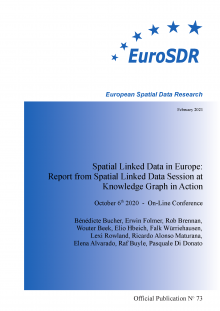Official Publication No. 73 (2021)
In 2020, the Knowledge Graph in Action (KGiA) online conference was organized as a joint event gathering three annual events with a common interest on producing, consolidating data, and supporting their joint reuse and different specific focuses within this common interest: the DBpedia day which more specifically focuses on advancing DBpedia, the EuroSDR Spatial Linked Data day which more specifically focuses on spatial linked data, and the EuroSDR VGI event which more specifically focuses on volunteered geographic information.
The event was organized around distinct parallel sessions dedicated to each event and joint plenary sessions. During plenary sessions, keynotes related to the modelling and the usage of spatial knowledge, in particular in the form of knowledge graphs, at the junction of these communities. Carsten Hoyer Click from the German Aerospace Center presented the design of a development of a distributed data infrastructure for energy systems analysis. Semantic Web techniques are used to interconnect data from different sources and prepare the integrated data layers needed for energy models. Peter Mooney from Maynooth University presented opportunities for more collaboration and geo-information integration between volunteered geographical information, the governmental agencies and the geospatial research communities. He insists on the complexity of data integration, which is always present even when flowcharts hide this complexity and on the semantics aspect being the more difficult to solve. Here the exploration of machine learning and artificial intelligence are the dominant trend. Marinos Kavouras from the National Technical University of Athens extended upon the need for our society to develop competences to interpret all the data available, in big quantities, to make sense of complex phenomena. He argues that space has been one of the strongest pivotal notions in semantically linking all kinds of data. Developing geospatial literacy skills is needed to empower people with a modern cartographic language, an indispensable communication and cognitive tool. Krzystof Janowicz from the University of California presented the application of knowledge graphs to address challenges at the interface between humans and their environment like for example crisis management. The information currently provided to end users is based on the integration of highly heterogeneous data from different fields of expertise and can lead to misinterpretation. Knowledge graphs and their technologies offer perspectives and lots of challenges still ahead to make data AIready at the level of individual statements instead of merely offering access to datasets, to provide additional contextual background information.
The rest of this report concerns presentations and exchanges that took place during the EuroSDR Spatial Linked Data sessions. EuroSDR is a not for profit association established since 1953 for the purpose of applied research and innovation in spatial data provision, distribution and usage in Europe. It gathers national mapping agencies, research institutes, universities and industries. Its activity on Linked data has two main objectives : 1) assessing the value of this technology in addressing current challenges in spatial data provision, distribution and exploitation, 2) identifying new needs for spatial data provision and distribution that have emerged with this technology. This activity started in 2015 and is grounded on big events -like the KGiA conference-, smaller working sessions, and since 2019 a technical group. EuroSDR LD group gathers participants with an interest in Spatial Linked Data (SLD). SLD can be characterized as a domain of applied research and innovation at the overlap between Linked Data and spatial data. Its finality is data production, sharing and reuse on the Web to support decisions with a geographical characteristic. Space is an important dimension to interconnect different information and achieve the Linked Data vision, for example to valorise linked data of different domains if any spatial footprints can be added to associate them with a geographical context or to detect possible connections between different data not connected otherwise. Vice versa, graph based models are promising approaches to address some unsolved issues in spatial data infrastructures.
The section “National presentations” reports on updates presented by different agencies or partners on latest developments, focusing on a given territory. These developments are either in a prototype stage or were presented as fully operational applications.
The remaining sections report on more technology oriented presentations.
The section entitled “Interfacing more users with data and related technologies” present results and approaches oriented on the appropriation of data by potential users, despite possible silos created by the complexity of data technologies, including linked data, was addressed in several presentations. The self-service GIS vision presented by the Kadaster is to support the querying and exploitation of complex data by more users beyond the limited Geomatics Community. The tools developed by Triply, in particular a wizard, focus on giving access to the potential of Linked data to users who are no LD specialists thanks to user oriented interfaces. Besides, a well known usage of Knowledge Graphs is to improve user access to resources -as on Amazon, AirBnB, Google and other platforms, based on the modelling in a knowledge graph of important knowledge related to the resources and also related to the usage. This can be applied in particular to specific resources: the data themselves. The discovery of “fitted for use” datasets, especially spatial datasets is a pending issue given the wide range of users on the one hand, and the difficulty to broker and compare datasets potentially relevant on the other hand. A new EuroSDR initiative targeting the design of an open European Knowledge Graph of geographical digital assets was presented. It consists of the collaborative creation of an open Knowledge Graph about digital assets in Europe, based on the EuroSDR LD Group sandbox and EuroSDR community as a whole.
The last section reported on GeoSPARQL focused presentations. A key technology associated with Linked Data and the Knowledge Graph is GeoSPARQL. One presentation focused on requirements from the domain of buildings and on the type of spatial queries that should be addressed to 3D linked data. Another presentation concerned the GeoSPARQL benchmark on the EuroSDR sandbox.

